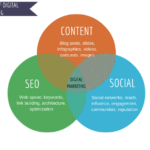If you’re unfamiliar with the term, “SEO” means “search engine optimization.” As to defining search engine optimization, that’s a broad topic. It’s all about search engines like Google and Bing, which use bots to crawl web pages. These searches use complex algorithms to analyze and then rank pages. Search engine optimization means to optimize web pages so that they rank higher in search engine results—and thus, drive more traffic to your site.
If you want to improve your search engine results, there is a lot to learn about SEO. It’s a complex subject with lots of little nuances. That’s why we’ve prepared an in-depth guide to SEO, what it is, and how you can use it to grow your audience and reach more people organically.
How Do Search Engines Work?

Search Engine Crawling
Crawling is the first step of the process. This is how search engines discover your website. They send out bots (also called crawlers or spiders) to find new content or to update existing content. This content can be in any format, like video, images, or a webpage, but it must be discoverable in the form of a link.
The crawling process is a simple one. It starts with bots fetching a few webpages. They then crawl those pages and follow links found within them in order to discover new URLs.
Search Engine Indexing
Indexing is exactly what it sounds like. As search engine bots find new links, these links are added to an index, which is an enormous database of content for web searchers to find.
This is why it’s important to make sure that all parts of your site are discoverable by search engine bots. Some choose to block crawlers from accessing parts of their site, or even the entire site, but if you choose to go this route, then it will be impossible for bots to discover your content and index it for searchers to find.
Search Engine Rankings

How Does SEO Work?
The basic explanation for how SEO works relies on three primary factors: quality, quantity and organic results. What this means is that first, your site must attract high quality traffic. This is the primary function of search engines, to provide users with the most relevant content possible for a given search—but you can help search engines along by using SEO techniques to make sure your content ranks for the right search terms. That’s what quality traffic means. These are the visitors who come to your site because they’re genuinely interested in your content rather than visitors who ended up on your site because the search they performed didn’t return relevant results.
The second factor is quantity, which is a big part of SEO. The quantity part of the equation means employing techniques that draw the highest number of visitors possible to your site via search engine result pages (SERPs).
Last, SEO focuses on generating organic traffic. On many SERPs, you will find that paid ads are a prominent part of the returned result. The goal of SEO is to generate organic traffic, which means traffic that you didn’t buy through paid advertising. SEO techniques help you build this kind of traffic by optimizing your pages so that they rank higher—for free.
How Does Organic Traffic Work?
To understand exactly how organic traffic works, it’s important to know which search results are organic, and which are not. Among SERPs, you’ll notice some links that are obviously paid, usually listed at the top as an ad. Then there are the “10 blue links,” which are the main event that most searchers are looking for. These 10 links are typically organic, which means you can influence them using SEO.
However, as search engines evolve, new types of search results keep emerging. For example, there is Google’s People Also Ask box, which lists questions related to what the searcher has searched for. Sometimes there are also image carousels, featured snippets, and other types of SERP features.
Today, the most notable SERP features are the People Also Ask boxes and the featured snippets. While there are some other features that aren’t paid advertising, like the snippets that appear when you ask a medical question, these usually come from predetermined sources like WebMD. People Also Ask and featured snippets, however, are purely organic—and that means that along with the 10 blue links, you can influence these via SEO, too.
How to Influence Organic Traffic Using SEO
Learning to influence search results requires learning about lots of little aspects that all go into web page design. This includes things like content, HTML, links and other details. In fact, when you look at all of the things that go into SEO, they can be broadly classified into two categories: on-page SEO factors, and off-page SEO factors.
On-page SEO factors are the things that are completely within your control. This includes the content you’ve created for each page, HTML headings, anchor text, and so forth. These are all things that are typically visible to the people who visit your site—and to search engine crawlers, too.
Off-page SEO factors are the things you can’t necessarily control. Your geographic location, for example, can influence your search ranking. Other off-page factors include your site’s reputation or the quality of the backlinks you’ve used. Not all off-page factors are visible to site visitors, but search engine crawlers take these things into account.
SEO best practices mean learning how to work with on-page factors in order to optimize your site, so let’s start there.
Why Quality Counts
In SEO context, quality refers to the quality of the content that you publish. High quality content—that is, content that is useful and well presented—ranks higher than low quality content.
The important thing to remember here is that search engines are capable of judging the quality of content. In fact, Google’s Search Quality Evaluator Guidelines will give you an in-depth look at what the search engine looks for when evaluating for quality. In brief, here are some guidelines to keep in mind:
- Content that is designed to be informational should be comprehensive, accurate, factual and presented in a professional way.
- News-worthy content needs to be well-cited, in depth, and the reporting should be original, not a rehash.
- Creative content should be unique, and it should represent a high level of skill.
Quality content is perhaps the most important part of your SEO efforts. You could consider it the foundation of your SEO strategy because without high quality content, all other SEO techniques will be less effective.
How to Use Keywords
In any conversation about SEO, the subject of keywords will invariably come up—and there is a lot of misunderstanding out there about how to properly use keywords. Gone are the days when search engines ranked sites by the number of times a particular keyword was used. That is a tactic known as “keyword stuffing,” and these days, it’s likely to lower your site’s rank in SERPs.
The best way to think of keywords is as a topic rather than a specific phrase that must be included on a page at all costs. For example, if you’re creating a site for a restaurant in Cleveland, your keyword research may reveal that searchers are using the “Cleveland restaurants” search term to find sites like yours. This doesn’t necessarily mean that you have to include “Cleveland restaurants” verbatim on your pages, however. Modern search engine algorithms are capable of contextual search, which means that so long as your site references the fact that the business is a restaurant located in Cleveland, this is enough to raise your ranking for the “Cleveland restaurants” search term.
The most important thing to remember about keywords is that one should never sacrifice content quality for the sake of keyword inclusion. Use keywords naturally within text, refrain from overusing them, and if a keyword doesn’t fit naturally into text, then don’t hesitate to use alternate variations of the term so long as the variant is grammatically correct.
How Freshness Factors into Search Engine Ranking
The freshness of your content is another on-page factor within your control. Search engines in general prefer up-to-date, timely content. That doesn’t necessarily mean that you need to constantly be publishing breaking news in order to rank high—but it does mean that whatever your industry niche, it helps to keep up with the latest news and industry trends.
With that, keep in mind that rehashing content can do more harm than good. So when publishing fresh content, be on the lookout for new angles that you can cover, or new topic areas that haven’t been explored quite as thoroughly as others.
Content freshness also comes into play regarding your old content. Though the content you publish today might be both relevant and popular, a year from now, that could change. Where older content is concerned, it’s wise to develop a management strategy to keep your site ranking high. This means that on aging pages, if possible, you can go through and make updates to those pages to bring them in line with current information or new trends. For example, a “top kitchen trends of 2016” post can be updated to the current year in order to make it fresh.
Sometimes, though, it just isn’t possible to make old pages new again. If that’s the case, don’t hesitate to archive these old pages. Keeping your site current and relevant helps give you a freshness boost in search rankings.
Making Links Work for You
After content, links are perhaps the most important factor to boosting your SEO. In general, there are two types of links that you will use: Links within your content that point to other sites, and backlinks, which are links on other sites that point to yours.
Links within your own content should follow a couple of basic rules. First off, to establish credibility and gain a boost to your search engine rank, it is important to use only links from trusted, high quality websites. In other words, it is better to link to major news sites or extremely popular and authoritative sites within your industry than it is to link to unknown sites. The higher authority links contribute much more to your search engine ranking.
It’s also important to choose the right anchor text when you create a hyperlink. That’s because when a search engine crawls your site, it uses the anchor text to understand what the linked URL is all about. This is also general good practice for your site visitors, too. No one likes to click a link that has nothing to do with the descriptive anchor text!
Next up are backlinks, which are also sometimes called “inbound links.” These are the links that point to your website from elsewhere. When you’re link building to gain backlinks, there are a few key things to remember:
- Gain backlinks from the highest quality sites that you can. Too many backlinks from low quality sites can get you penalized.
- Avoid black hat link building tactics, which include buying backlinks, aggressive guest posting schemes, link exchanges, spamming comment sections and so on. Each of these things can result in a penalty.
- When you are link building, the best way to go about it is to simply ask by reaching out to the owner of a quality, relevant site and asking them if they will give you a backlink.
As with content, the key to links and SEO is quality over quantity. Less can be more if you are selective about the sites you link to, and those you build backlinks with.
How Does Site Architecture Help SEO?
Fresh, quality content and keywords are only part of the SEO equation. Your site’s architecture and performance can also provide a boost—or a drop in rankings if it’s not performing as well as it should. Most of the time, these things aren’t a big concern, but you should be aware of certain defects that can drop your ranking.
- Make sure your site is free of broken or improper links.
- Optimize page load speeds with things like compressed images to prevent slow load times from harming your rank.
- Keep your site free of user access prompts.
- The “noindex” value can be used to prevent crawlers from searching your site, so you’ll want to make sure that you’re not using this.
- Avoid using duplicate content because not only does this affect your site’s freshness, but it also makes it harder for search engines to tell which page is best from among many with similar content.
- Use descriptive keywords within your URLs to make it easier for both search engines and visitors to know what the page is about.
Last of all, make sure that your site supports mobile use. All pages, whether optimized for mobile or not, can be viewed on mobile devices, but in order to rank, your site should feature a mobile architecture alongside the desktop version featuring all the same content as the desktop version.
This is important because these days, the majority of searches happen on mobile devices. Thus, search engines like Google now use mobile-first indexing, which means the mobile version of a website is what the crawlers look at first when indexing your site.
Using HTML to Your Advantage
HTML elements are yet another factor that can affect your SEO. These include elements like your titles, meta descriptions and your HTML headings.
- HTML titles—the headline of your page—are one of the most important elements that search engines look at when determining what a page is about. They are also what displays as the blue link in SERPs. Therefore, they should be concise, relevant to what the page is about, and descriptive.
- Meta descriptions aren’t always featured in SERPs, but they can be. Sometimes, however, search engines choose a snippet from the page’s test. Still, it’s good to include a descriptive meta description because when search engines do display them, well-crafted meta descriptions entice users to choose your site from among other results.
- Heading tags (like <h1>, which is for titles, and <h2> and lower, which are for subheadings) are a good way to structure your content and also give search engines a clearer picture of what your content is about. It’s a wise idea to include keywords here—though be sure not to stuff headings with keywords. For site visitors, subheadings make the page easier read and thus, makes them more inclined to stay on your page longer or revisit at a later date.
SEO is a complex topic with lots of little facets. However, these are the basics that will get you started. Remember that quality content is king, and all the rest—like links, HTML tags and other elements—are things you can use to boost your site even higher in SERPs.
If you could use help with your website, we’ve got you covered, from on our fully managed SEO offering, to individual needs like our keyword research service or on site SEO service.






